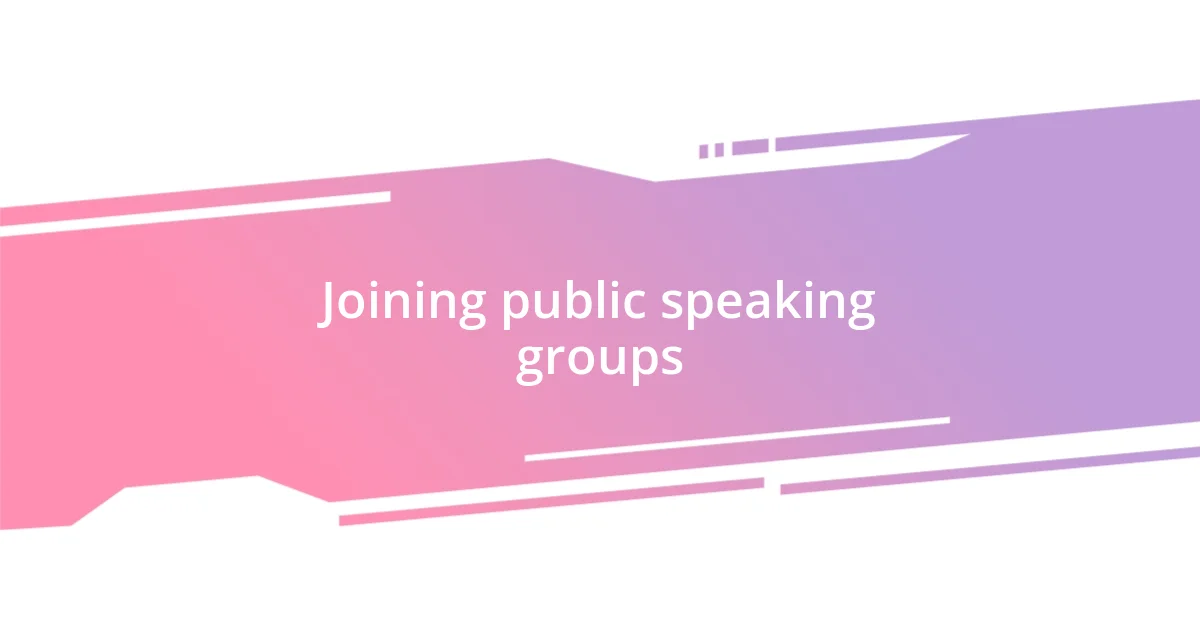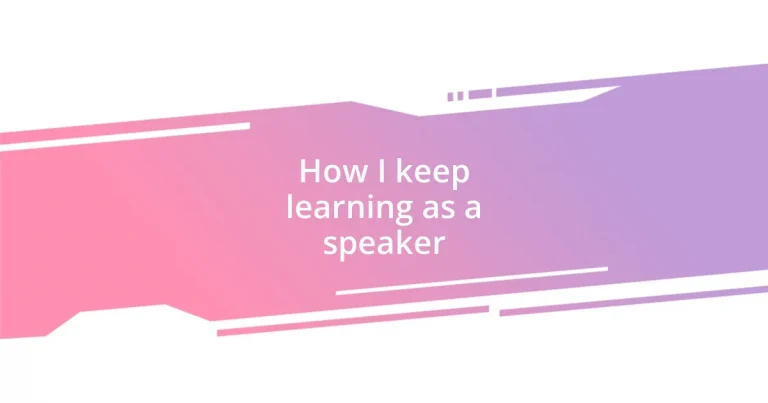Key takeaways:
- Engaging with diverse resources, including TED Talks, books, and workshops like Toastmasters, significantly enhances speaking skills through inspiration and community support.
- Seeking and incorporating audience feedback after presentations fosters real-time improvement and allows for tailored, impactful messaging.
- Setting specific learning goals and reflecting on personal growth keeps the speaker motivated and adaptable, ultimately leading to a more authentic and engaging speaking style.

Finding valuable speaking resources
When I’m on the lookout for valuable speaking resources, I often turn to platforms like TED Talks. They’re not just inspiring; they offer a masterclass in various speaking styles and techniques. There’s something powerful about watching a speaker engage an audience. Do you ever feel a particular spark when you see someone effortlessly captivate a crowd? I certainly do.
Books on public speaking have also been a treasure trove for me. One that truly transformed my approach was Dale Carnegie’s “The Quick and Easy Way to Effective Speaking.” It’s filled with practical tips, but what struck me most was Carnegie’s emphasis on connecting with your audience emotionally. Isn’t it fascinating how a well-told story can resonate more than factual data? This realization motivated me to infuse more personal anecdotes into my speeches.
Lastly, I find value in workshops and speaking clubs, like Toastmasters. I’ve met remarkable people there, each with their unique stories and challenges. One time, a fellow member shared how she overcame her fear of public speaking by simply practicing in front of a mirror. Have you ever tried that? It was inspiring to see how personal growth can ignite confidence. Engaging in these communities often opens up new perspectives and resources I wouldn’t have discovered otherwise.

Joining public speaking groups
Joining public speaking groups has been a transformative experience for me. In these environments, I’ve found an incredible mix of support and constructive feedback. I recall my first Toastmasters meeting; I was nervous but captivated by the vibrant energy in the room. Listening to others share their stories made me realize we all have something to prove and improve. That shared struggle fosters a sense of camaraderie that’s both uplifting and motivating.
Here are some benefits I’ve experienced from joining public speaking groups:
- Constructive Feedback: Receiving feedback from peers helps me refine my delivery and content dramatically.
- Networking Opportunities: I’ve met speakers and mentors who inspire me to push my boundaries and try new techniques.
- Skill Variety: Participating in various speaking styles and formats, from impromptu speeches to prepared presentations, expands my adaptability.
- Confidence Building: Regularly presenting in a supportive setting has allowed me to conquer my fears and present with assurance.
- Community Support: Sharing experiences with fellow speakers cultivates a safe space for vulnerability and personal growth.
Overall, being part of these groups feels like an ongoing journey of discovering not just how to speak better, but how to connect and engage more deeply with others.

Practicing through speaking engagements
Practicing through speaking engagements truly serves as a vital component of my development as a speaker. Every opportunity to present is like stepping onto a live stage where I can test new techniques and gauge audience reactions. Recently, I spoke at a local community event, and it was eye-opening to see how slight adjustments in my tone could shift the atmosphere in the room. Have you ever noticed how your energy can influence the audience’s engagement? It’s a fascinating dynamic that reinforces the importance of practice.
I’ve also discovered that these speaking engagements offer real-time feedback, which is invaluable. At one particular event, I received comments that highlighted aspects of my delivery I hadn’t even considered—like the pace at which I spoke and how it affected audience comprehension. Those moments are gold; they push me to refine my craft. I encourage you to seek opportunities to present, whether in community gatherings or professional conferences. They are excellent testing grounds for honing your skills and growing your confidence in public speaking.
Moreover, practicing through various engagements helps solidify my ability to adapt quickly to different audiences and settings. I once had to switch my speech content on the fly because of a last-minute change in the audience demographic. That experience taught me the value of staying flexible and trusting my instincts. How do you handle unexpected changes when you’re speaking? I’ve learned that the more I practice in different environments, the more prepared I feel for whatever comes my way.
| Speaking Engagements | Benefits |
|---|---|
| Community Events | Engages with diverse audiences and allows for real-time feedback. |
| Workshops | Provides opportunities for in-depth practice and expert insights. |
| Conferences | Challenges me to convey complex ideas succinctly. |

Seeking feedback from audiences
Seeking feedback from audiences has truly transformed my approach to speaking. After one of my talks at a professional conference, I made it a point to stay behind and chat with attendees. Their insights didn’t just highlight what I did well; they opened my eyes to nuances I hadn’t considered—like how certain jokes landed or fell flat. Can you imagine how enlightening it is to hear firsthand about your impact? It’s an experience that has definitely shaped my future presentations.
I find it equally important to create an environment where my audience feels comfortable sharing their thoughts. At one session, I encouraged participants to evaluate my performance anonymously through a quick survey. The feedback was eye-opening. Some audience members appreciated my storytelling, while others wanted more data-driven content. This blend of perspectives reminded me that every audience is unique, and tailoring my message can significantly enhance engagement. Have you ever thought about how audience diversity challenges your usual patterns?
Moreover, I routinely ask for specific feedback during Q&A sessions. This practice not only invites interaction but also provides me with real-time insights into audience comprehension. One memorable experience was when someone asked about a technical term I had used. I was grateful for the question because it prompted me to clarify my point and realize the importance of using accessible language. This simple yet powerful feedback process transformed my speaking style, making it more inclusive and relatable. How do you currently seek audience input and adapt your presentations? Implementing these strategies can be a game-changer for any speaker.

Analyzing successful speakers
Analyzing successful speakers has become a rewarding exercise for me, as I often find myself captivated by their techniques and storytelling methods. I recently watched a TED Talk that left me reflecting for days. The speaker’s ability to weave personal anecdotes into the core message made it relatable and memorable. Have you noticed how some speakers can draw you in with just a single story? It’s a reminder to me that vulnerability can be a powerful tool in connecting with the audience.
I also pay close attention to how successful speakers handle their body language. There was a moment when a renowned speaker stepped away from the podium and walked among the audience during their presentation. It created an immediate connection, making their message feel more personal. Can you recall a time when a speaker’s presence made a lasting impression on you? Those small shifts in physical movement can knock down barriers, inviting more engagement and warmth.
Another fascinating aspect I’ve observed is how experts often use pacing to their advantage. I remember closely studying a speaker who would deliberately pause to let a powerful point resonate. It had an almost magical effect, increasing the room’s tension in anticipation of what would come next. Have you ever tried pausing intentionally during your talks? It can help emphasize key messages while giving your audience a moment to reflect. Analyzing these intricate details not only expands my toolkit as a speaker but also inspires me to experiment with innovative approaches in my own presentations.

Updating my personal speaking style
Updating my personal speaking style has been a continuous journey of exploration and growth. I remember the first time I decided to infuse humor into a serious topic during a workshop. Initially, I was apprehensive, fearing it might undermine my message, but the response was overwhelmingly positive. It taught me that humor can not only break the ice but also create a connection with the audience that feels genuine. Have you ever seen laughter ease the tension in a room? It’s a reminder that a good laugh can pave the way for deeper engagement.
I’ve also been revisiting my perfect pace and tone. I recall a feedback session where someone remarked that my voice was too monotone during a passionate segment. It was a wake-up call! I immediately experimented with varying my intonation and speed. Taking a quick breath before key points not only made my delivery more dynamic but also helped maintain audience interest. Have you ever noticed how a simple change in tone can shift the energy in the room? It’s like uncovering a hidden layer of your speaking persona.
Reflecting on these changes, I realize that authenticity remains at the heart of my style update. Consciously integrating my true self into my presentations has made me feel more comfortable on stage. After shedding the rigid outlines I used to rely on, I now speak more freely, trusting my instincts. How often do we hold back because we think we should fit a mold? Embracing my individuality has not only invigorated my speaking style but also resonated with audiences who see the real me.

Setting ongoing learning goals
Setting ongoing learning goals has been essential for my growth as a speaker. I vividly recall a moment when I decided to aim for one major speaking engagement every quarter. It was a game changer! Setting this specific target kept me motivated and accountable. It made me eager to learn new techniques in every presentation I prepared for, ensuring that I was always progressing. Have you considered what kind of goals could elevate your speaking further?
Beyond just booking gigs, I also reflect on the skills I want to master each year. For instance, last year, I focused on enhancing my ability to handle Q&A sessions. I set a goal to practice improvisational techniques for handling unexpected questions. The thrill of spontaneity became one of my favorite elements of speaking. It challenged me to think on my feet while also making my presentations feel more interactive. What skills could you challenge yourself to improve upon?
I’ve found that writing down these goals helps solidify my commitment. I keep a journal where I track my progress and reflections. Last month, I set a goal to read at least one book on public speaking every month. With each book, I gain fresh insights to incorporate into my style. Have you ever noticed how the act of writing goals can transform abstract ideas into concrete plans? It’s this process of reflection that allows me to set new learning goals and eagerly anticipate the growth that will follow.














